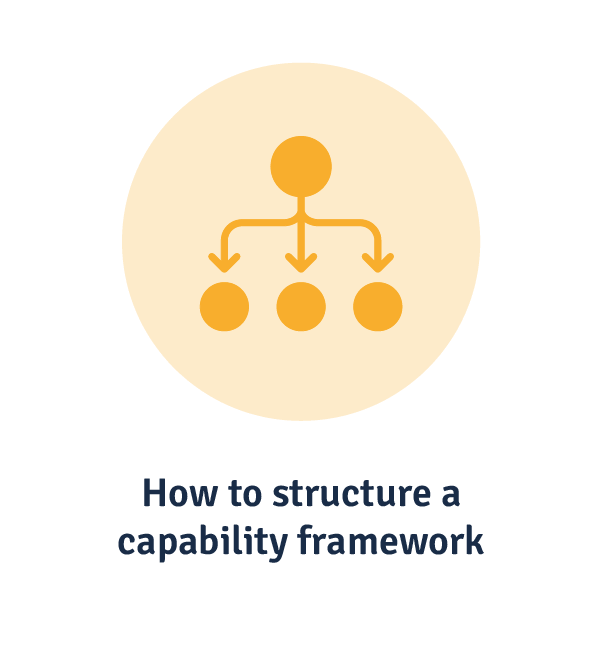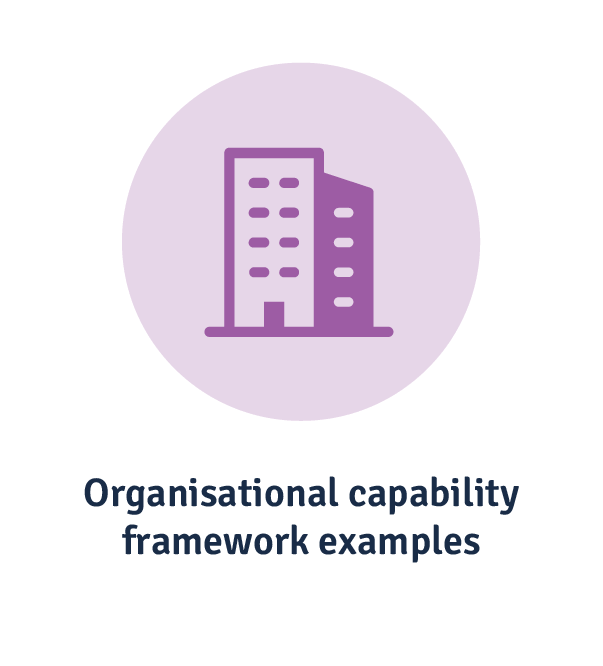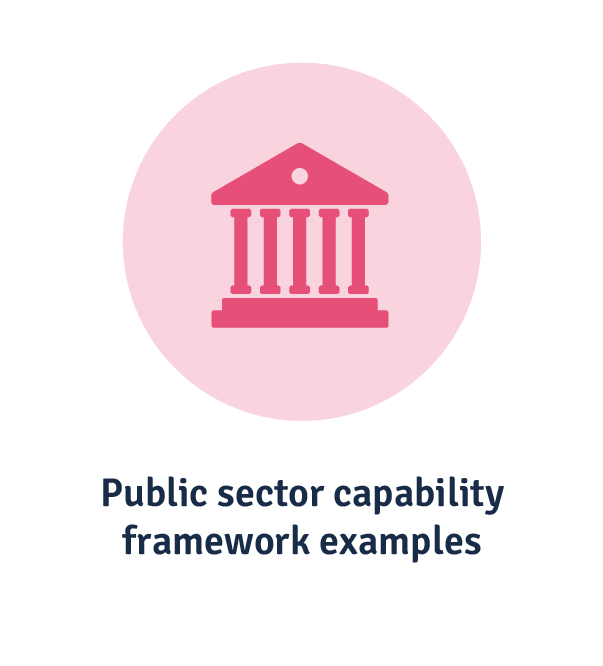4 Capability Framework Examples and How They Are Used in Organisational Strategy
Implementing a capability framework in your organisation can be a daunting task, least of all because it is meant to be a sustainable business tool. Even more so if you’re starting from scratch. It’s handy to have a few examples when building your capability framework.
In this guide, we’ll take a look at four examples of the capability framework in public sector and private businesses, how and why they utilise their frameworks differently, and the key elements to include in your own framework.
Without further ado, let’s dive in.
What is a capability framework?
A capability framework outlines the skills, knowledge, tools, processes, and behaviours your organisation needs to achieve its goals. It establishes a universal language in your workforce, offers information for career planning and enables clearer workforce planning.
How to use a capability framework
Done right, a capability framework should be accessible and understandable for everyone in your organisation. That includes individual contributors, organisational development professionals, HR, L&D, managers and executives.
That gives you an incredibly diverse set of use cases, beyond simply developing a capable workforce. A framework can be the foundation for:
- Consistent but nuanced role descriptions across functions
- Best practice and impartial recruitment processes
- Informed performance management and development
- Talent mobility based on universal descriptions of capability requirements and availability
- Strategic learning and development pathways
- Individual career planning for employees
- Analysing current and future talent gaps.
How to structure a capability framework
Despite the myriad of people it is meant to help, a capability framework is not as complex a concept as it sounds.
It will take time and the help of key stakeholders to develop, but there are only a few key elements you need to outline when creating your own capability framework.
Think of a framework as layered. That gives you a breakdown of:
- Core capabilities
- Sub-capabilities
- Competency levels.
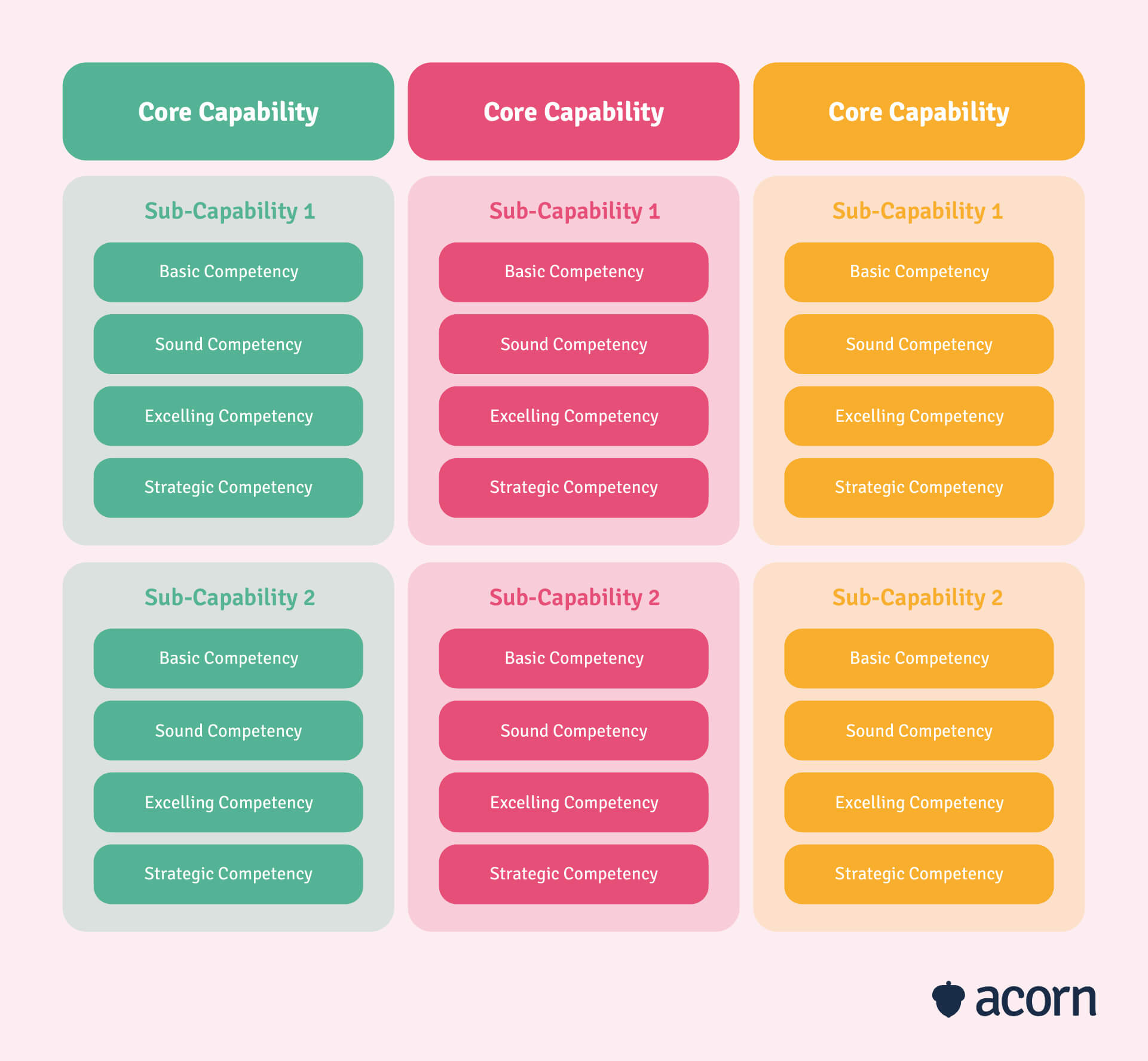
Also keep in mind that there’ll be other business processes and policies that will have to align with a capability framework, which will influence the language you use.
Think about learning and development. Most corporate learning—and the solutions designed for it—is based on the broken promise of skills taxonomies, which don’t address business goals. This is part of what lead us to create the performance learning management system (PLMS).
It’s designed to align directly with your capability framework, so that you can map content to capabilities and then build specific learning pathways based on job role, performance and business needs. This way, you’re codifying and operationalising capabilities to improve organisational efficiency and providing impactful and contextual learning opportunities. Win-win.
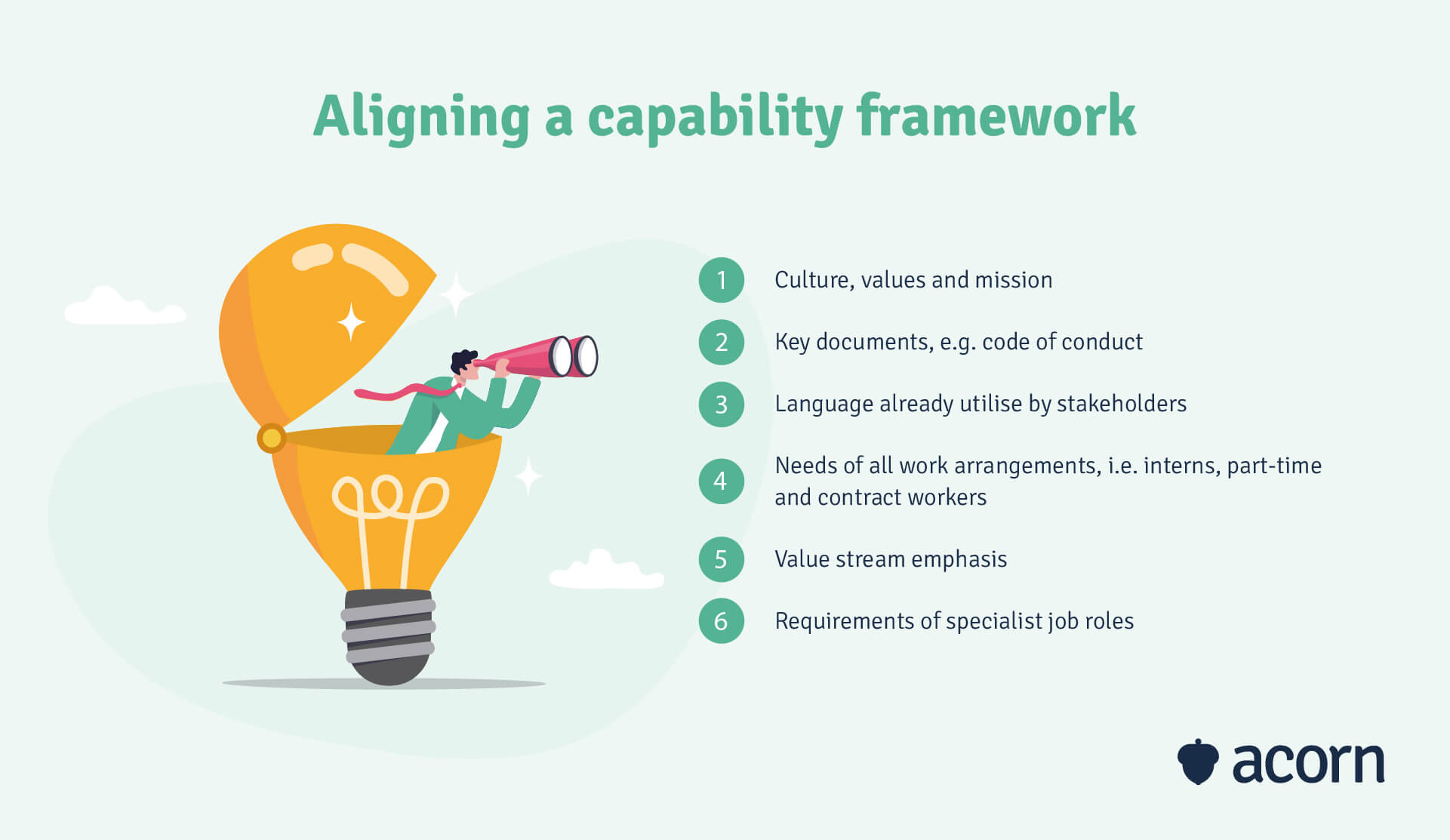
Core capabilities
Core capabilities are the overarching groups of capabilities in your framework. Most frameworks utilise more generic language at this level, like:
- Strategic alignment
- Driving results
- Governance
- Personal attributes.
This organisation of capabilities is kept deliberately minimal, as context will come from sub-capabilities and their corresponding competencies.
When defining core capabilities, look to business drivers or functions and their reinforcing activities. They are core for a reason. Without even one, your organisation would be flying blind, which is why they sit at the top of your framework.
Sub-capabilities
Under each core capability will be a collection of sub-capabilities that further anatomise critical key skills, behaviours and knowledge.
The number of sub-capabilities under a core capability is really up to your organisational needs. Public sector frameworks generally stick to around three to five sub-capabilities, while enterprise frameworks can often have as many as 10.
When developing a capability framework, remember that capabilities are unique and exhaustive. Even if you take a role-based approach to organising capabilities, remember that they are largely transferable skills, behaviours and knowledge.
There shouldn’t be replication of capabilities across departments because:
- That’ll only create silos and inefficiencies in ways of work.
- All sub-capabilities still belong to core capability groups. That means there is a common ground for expected behaviours and processes.
Competency levels
Managing performance of capabilities comes courtesy of competencies. All capability frameworks utilise competencies in some way, though you’ll most commonly see them referred to as performance descriptors or measures of proficiency.
To define competency levels, break capabilities into behaviours or job roles.
For example, you may have the sub-capability of Coaching talent. A foundational competency could be Sharing own knowledge and experience to develop others.
We say foundational, because competencies don’t exist in a vacuum. They are generally a scale or spectrum measured with language such as foundational, proficient, advanced and strategic. If you’re not a fan of the grading scale, you can always assign competency to job levels like the ACT Public Service does.

Optional: Specialist capabilities
You may want to add a specialist stream of capabilities to better reflect organisational requirements. As this is more work for you, the time to do this is when there are additional or potentially complex expertise and behaviours tied to job roles or families.
It’s most commonly seen in a broader stream like leadership capabilities or a niche one for your legal department, as an example.
Organisational capability framework examples
Here’s the thing. Enterprise capability frameworks are hard to come by, and for good reason: They are an organisation’s secret sauce recipe.
A capability framework will outline business objectives and the essential knowledge, skills and behaviours that achieve their organisational success. Many organisations will create multiple specialist frameworks too, such as a sales capability framework.
So, we have to look to consultants.
Deloitte’s leadership capability model is a good example of using strategic drivers as the tent poles of your framework.
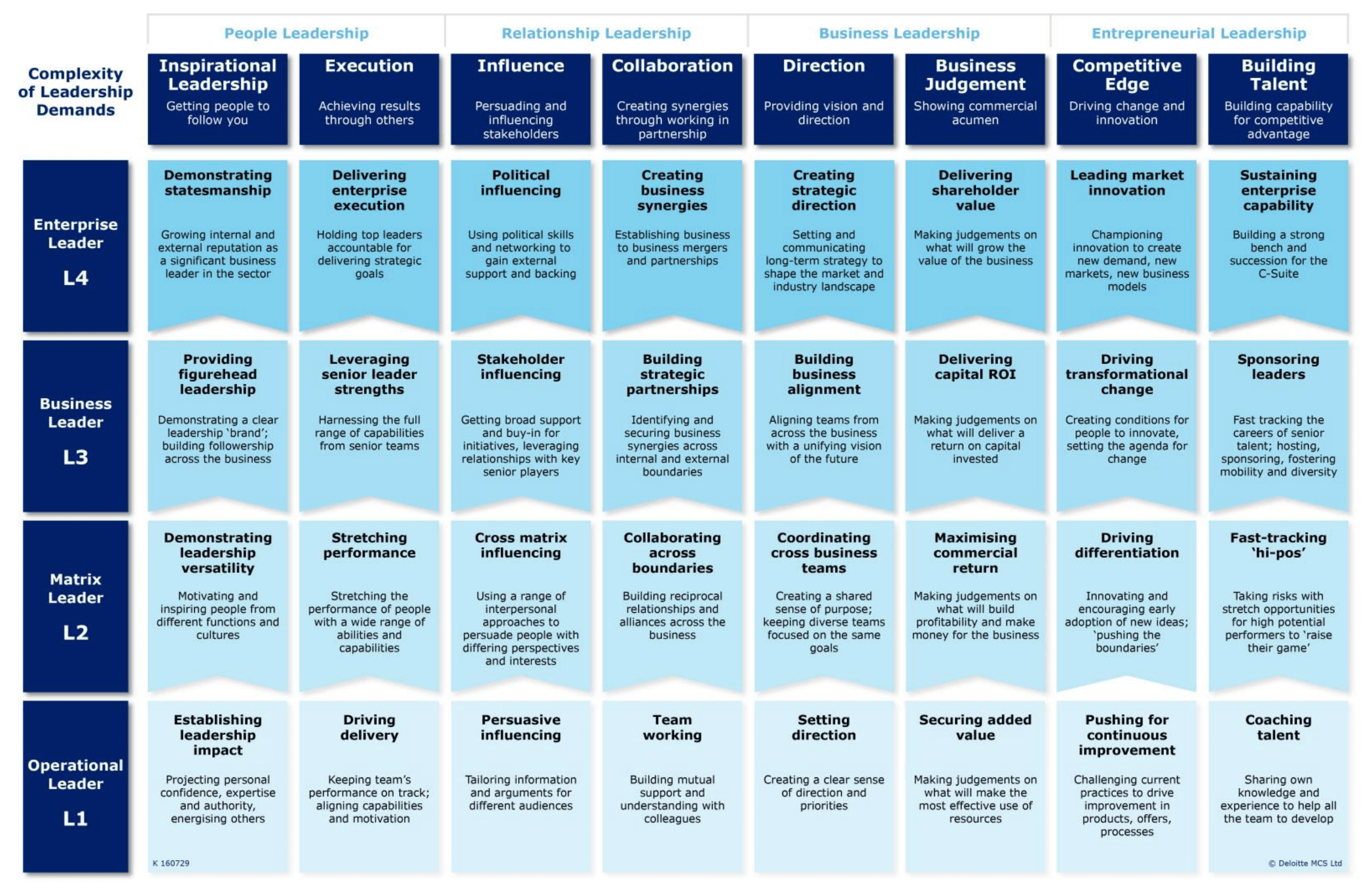
Core capabilities are derived from the most complex leadership responsibilities, grouped under people, relationship and business leadership. But from there, sub-capabilities—not just competencies—are linked to specific levels of leadership.
Similarly, the Learning and Performance Institute (LPI) has a capability framework for L&D professionals. It uses five core capability groups for 25 sub-capabilities, each with four measurable levels of competency (and the baseline competency of no experience).
These measures of competency are not tied to job roles, but an ultimately strategic display of performance. The framework is considered a descriptive idea of best practice, based on a key set of principles that all L&D professionals should uphold.

The takeaway from these examples
At its core, a capability framework should effectively align performance with organisational outcomes. You don’t need to create a specific leadership model to do this (though it is a framework rooted in organisational goals more firmly than most others). Just remember that for every behaviour, skill, process or expertise noted, there should be a strategic impact felt by the performance of that capability.
Public sector capability framework examples
We’ve already done a truckload of research breaking down public sector capability frameworks (read more here). However, we’ll talk a closer look at a couple here.
Most public sector frameworks follow a few core principles.
- An agile approach to capability creation and prioritisation rooted in the often unpredictable nature of their environment (think: pandemics, changing budgets, social upheaval).
- Capabilities developed in tandem with changing workforce plans, which adds to the need for agility.
- Just as much effort is put into creating supporting resources that help the workforce better understand how to use the framework.
On that note, let’s look at a couple of examples.
NSW Public Service Commission capability framework
One of the most accessible capability framework examples out there comes courtesy of the NSW Public Service Commission (PSC).
They outline 20 organisational capabilities organised into five groups, where each sub-capability has five levels of competence.

In their guide, each sub-capability is denoted by its core capability, a performance descriptor of the sub-capability itself and its competency levels.
Generally speaking, there are more performance indicators given as the competencies scale in complexity. This isn’t necessary for all frameworks, but is useful for those that don’t tie capabilities to job roles within the structure of the framework itself.
In fact, that context comes from the myriad of resources the PSC provide to aid in using the framework, including:
- An application tool that helps employees demonstrate their capabilities in job interviews.
- A summary of the latest changes made to the framework.
- A discovery tool for self-reflection.
- User guides for processes like onboarding, professional development, recruitment and workforce planning.
Office of Personnel Management competency approach
Quick note: The American vernacular uses competency, but we and many industry thinkers prefer capability. Ultimately we’re talking about the same thing, though we have our own definition for competency.
The Office of Personnel Management (OPM) has a big job in helping to create, catalogue and utilise government-wide capabilities. Their capabilities are created and framed within the context of nearly 200 federal job roles.
They then offer two approaches to the departments they serve.
- Ready-made frameworks for certain functions, such as cybersecurity and IT.
- A list of identified capabilities that local HR units can utilise to manage performance, design roles and create development opportunities.
Their leadership model is the best example of this. Every sub-capability comes with a competency level, a definition of that competency and an illustration of that in action. The capability of Flexibility is needed of leaders across departments, with the corresponding competencies (or proficiencies) offering clear expectations for performance.

The takeaway from these examples
Both of these examples act simply as a pool from which functional managers and human resources can draw from for processes like:
- Job role design
- Performance management
- Talent mobility
- Career planning.
However, both utilise cumulative levels of competency as a definitive measure of performance, regardless of the parameters for measurement. This allows for defined capabilities to more freely mapped to job roles across departments, and ensures there is enough context for the framework to be used by all stakeholders.
Key takeaways
It could be argued that the public sector makes their frameworks as workforce tool, placing a heavy emphasis on career planning and development, while enterprise capability frameworks focus on defining strategic drivers. We’re not going to tell you one approach is better than the other—rather, that a blended one is the best way forward.
That gives you a few takeaways to carry with you when developing your own framework.
- Start by thinking about business outcomes, no matter if you’re building a framework for a specific function or use case. All capabilities should have an impact on your business mission or strategy.
- All capabilities should have measures of competency, as these are the indicators that enable performance management.
- Capabilities can change if your strategy does. Regular environmental scans will tell you if your framework is sustainable.
- Think about capabilities as tasks and behaviours. This will help you create them from strategic drivers.
- While a crucial business tool, a capability framework needn’t be overly complex. Consider creating supporting resources to enable widespread adoption and use.
- Your framework should be unique to you. Whatever inspiration you take from these examples, consider how work needs to get done by your workforce, within your business architecture and to the standard that you set for organisation.
Related Reads on This Topic

Why Competency Management is Important for Strategic Performance Management
Competency management is the key to strategic performance management and uncovering capability gaps in your workforce…

How to Do Capability Mapping Like a Pro
Learn how the capability map can be used to define your current state of business and the gaps to cover for future success…

How to Assess, Develop and Strengthen HR Capability in Your Organisation
Get the step-by-step guide on how to create human resources capabilities and implement them in your organisation…

